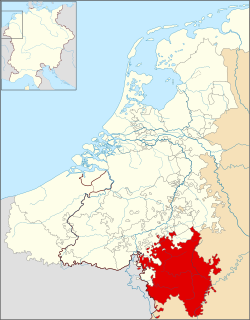Count of Luxembourg
| County of Luxemburg | ||||||||||
|
Grofschaft Lëtzebuerg (lb) Grafschaft Luxemburg (de) Comté de Luxembourg (fr) |
||||||||||
| State of the Holy Roman Empire | ||||||||||
|
||||||||||
|
||||||||||
|
Luxembourg within the Low Countries, 1350
|
||||||||||
| Capital | Luxembourg | |||||||||
| Languages | Luxembourgish, German, French | |||||||||
| Religion | Catholic Church | |||||||||
| Government | Feudal monarchy | |||||||||
| Count of Luxemburg | ||||||||||
| • | 1059–1086 | Conrad I (first) | ||||||||
| • | 1346–1353 | Charles IV (last) | ||||||||
| Historical era | Middle Ages | |||||||||
| • | Obtained by Sigfried | 963 | ||||||||
| • | Acquired by Luxembourg dynasty | 1214 | ||||||||
| • | Raised to duchy by the Emperor | 1353 | ||||||||
| • | Held by the Dukes of Burgundy | 1443 | ||||||||
| • | To Habsburg | 1482 | ||||||||
| • | Occupied by France | 1794 | ||||||||
| • | Grand Duchy re-established | 1815 | ||||||||
|
||||||||||
The County of Luxemburg (French: Luxembourg, Luxembourgish: Lëtzebuerg) was a State of the Holy Roman Empire. It arose from medieval Lucilinburhuc ("Little Fortress") Castle in the present-day City of Luxembourg, purchased by Count Siegfried in 963. His descendants of the Ardennes-Verdun dynasty (Wigeriche) began to call themselves Counts of Luxembourg from the 11th century onwards. The House of Luxembourg, a cadet branch of the Dukes of Limburg, became one of the most important political forces of the 14th century, contending with the House of Habsburg for supremacy in Central Europe.
The historic region of Luxembourg was settled by Celtic tribes in the 2nd Century. After the conquests of Julius Caesar during the Gallic Wars from 58 to 51 BC, it was incorporated into the Roman province of Germania Inferior. Upon the invasion of Germanic Franks from the East during the Migration Period in the 5th century, the Luxembourg region became part of Francia and the Carolingian Empire. In 843, Luxembourg became part of Middle Francia (Treaty of Verdun), then Lotharingia in 855 (Treaty of Prüm) and, finally, of Upper Lorraine in 959. Since 925, it has belonged to East Francia, predecessor of the Kingdom of Germany and the Holy Roman Empire, and large parts were held by the Abbey of Echternach.
...
Wikipedia



